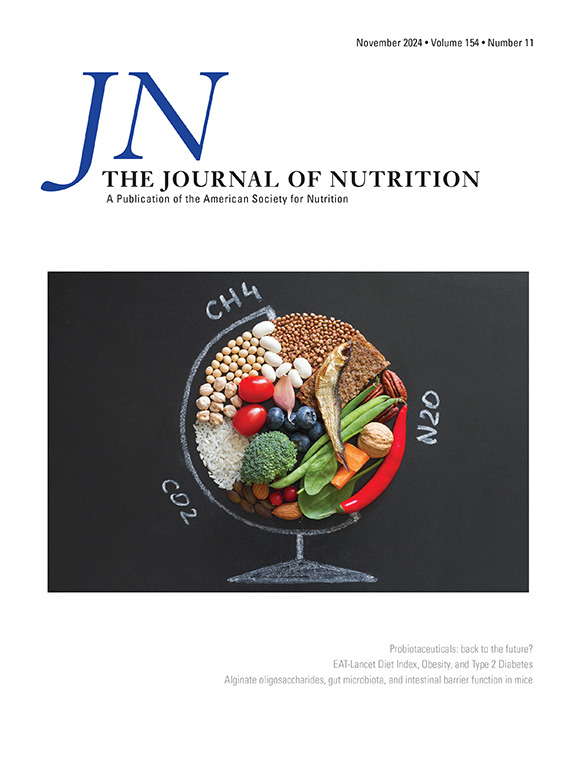不同来源蛋白质摄入、血浆氨基酸含量与慢性肾脏疾病的关系。
IF 3.7
3区 医学
Q2 NUTRITION & DIETETICS
引用次数: 0
摘要
背景:不同食物来源的蛋白质和不同血浆氨基酸与慢性肾脏疾病(CKD)风险的关系尚不清楚。目的:我们旨在调查不同来源的膳食蛋白质摄入量和血浆氨基酸含量与普通人群新发CKD的纵向关系。方法:基线时无CKD的参与者(平均年龄:56岁)来自UK Biobank,其中176,980人被纳入蛋白质摄入量分析,99,061人被纳入血浆氨基酸分析。根据前一天24小时的饮食回忆收集膳食蛋白质信息。血浆氨基酸浓度通过高通量核磁共振代谢生物标志物分析平台测量。研究结果为新发CKD。结果:在中位随访12年期间(2006 - 2010年开始,2021年结束),3,542名参与者(2,128,626人/年)出现新发CKD。较高的乳源性和鱼源性蛋白质摄入量与较低的CKD发病率相关(每标准差,标准差增量,校正风险比,HR[95%置信区间,95% ci]分别= 0.95[0.91-0.98]和0.95[0.92,0.99]),但其他食物的蛋白质摄入量则不相关(趋势P为0.0.1)。此外,血浆组氨酸较高的患者CKD发生率较低(每SD增量;调整后HR =0.90;95% CI: 0.86-0.95),酪氨酸(0.90;0.87-0.94),异亮氨酸(0.89;0.85-0.92),亮氨酸(0.89;0.85-0.93),缬氨酸(0.89;0.85 - -0.93)。结论:乳制品和鱼类蛋白质摄入量以及血浆组氨酸、酪氨酸、异亮氨酸、亮氨酸和缬氨酸浓度与新发CKD呈负相关。本文章由计算机程序翻译,如有差异,请以英文原文为准。
Relationship of Different Sourced Protein Intake, Quantity of Plasma Amino Acid with Chronic Kidney Disease
Background
The association of protein from different food sources and different plasma amino acids with risk of chronic kidney disease (CKD) is unclear.
Objectives
We aimed to investigate longitudinal relationships of dietary protein intake from different sources and quantity of plasma amino acids with new-onset CKD in the general population.
Methods
Participants (mean age: 56 y) without CKD at baseline were included in the UK Biobank. A total of 176,980 were included in the analysis for protein intakes and 99,061 participants were included in the analysis for plasma amino acids. Information on dietary protein was collected based on a 24-h dietary recall from the previous day. Plasma amino acid concentrations were measured by a high-throughput nuclear magnetic resonance (NMR)-based metabolic biomarker profiling platform. The study outcome was new-onset CKD.
Results
During a median follow-up of 12 y (beginning between 2006 and 2010 and ending in 2021), 3542 participants (2,128,626 person-year) developed new-onset CKD. Higher intakes of dairy-derived and fish-derived protein were associated with lower incidence of CKD [per standard deviation, SD increment, adjusted hazard ratio, HR (95% confidence interval, 95% CI): 0.95 (0.91, 0.98) and 0.95 (0.92, 0.99), respectively], but protein intake from other foods was not (P-trend > 0.1). Moreover, incident CKD was lower among those with higher plasma histidine (per SD increment; adjusted HR = 0.90; 95% CI: 0.86, 0.95), tyrosine (0.90; 0.87, 0.94), isoleucine (0.89; 0.85, 0.92), leucine (0.89; 0.85, 0.93), and valine (0.89; 0.85, 0.93).
Conclusions
The protein intake from dairy and fish, as well as the concentration of plasma histidine, tyrosine, isoleucine, leucine, and valine, was inversely associated with new-onset CKD.
求助全文
通过发布文献求助,成功后即可免费获取论文全文。
去求助
来源期刊

Journal of Nutrition
医学-营养学
CiteScore
7.60
自引率
4.80%
发文量
260
审稿时长
39 days
期刊介绍:
The Journal of Nutrition (JN/J Nutr) publishes peer-reviewed original research papers covering all aspects of experimental nutrition in humans and other animal species; special articles such as reviews and biographies of prominent nutrition scientists; and issues, opinions, and commentaries on controversial issues in nutrition. Supplements are frequently published to provide extended discussion of topics of special interest.
 求助内容:
求助内容: 应助结果提醒方式:
应助结果提醒方式:


